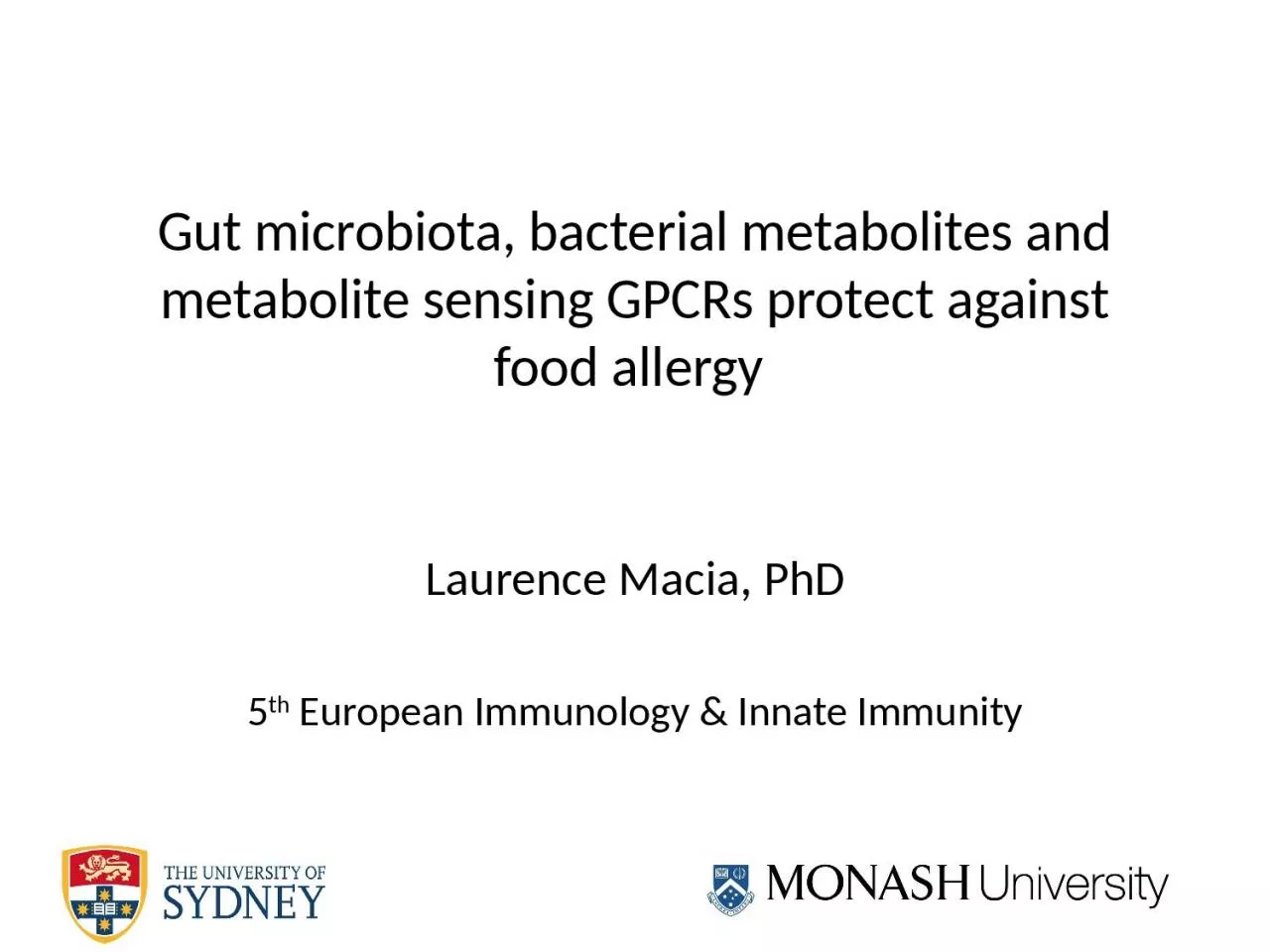

Laurence Macia PhD 5 th European Immunology amp Innate Immunity Increased prevalence of inflammatory diseases over the last 50 years 19601979 After 1980 Molodecky et al Gastroenterology 2012 ID: 934323
Download Presentation The PPT/PDF document "Gut microbiota , bacterial metabolites ..." is the property of its rightful owner. Permission is granted to download and print the materials on this web site for personal, non-commercial use only, and to display it on your personal computer provided you do not modify the materials and that you retain all copyright notices contained in the materials. By downloading content from our website, you accept the terms of this agreement.
Slide1
Gut microbiota, bacterial metabolites and metabolite sensing GPCRs protect against food allergy
Laurence Macia, PhD5th European Immunology & Innate Immunity
Slide2Increased prevalence of inflammatory diseases over the last 50 years
1960-1979
After 1980
Molodecky
et al, Gastroenterology 2012
Slide3Increased prevalence of inflammatory diseases in western countriesMASOLI, M. ET
AL, Nature, 2011, 479, S2–S4 THE GLOBAL BURDEN OF ASTHMA (2004)
Slide4Causes?GENETIC
WESTERN LIFESTYLE
NUTRITION TRANSITION
Western diet
: High carbohydrate, high saturated fat and
low in
fibre
Slide5Diet and gut homeostasis
as a basis for certain western lifestyle diseases
From
Maslowski
and Mackay Nat.
Immunol
2011
Type 1 diabetes
Asthma
Food allergies
IBD
Slide6Role of diet and gut microbiota in food allergy
Current treatment=Food avoidance
Slide7Food allergyWhat
is it: Inappropriate immune response to innocuous (food) antigenSymptoms: Swelling, itching, wheezing, diarrhea, difficulty in breathing, anaphylaxis
Prevalence: High in Western countries, up to 1 in 10 affectedCause?? Hygiene hypothesis
Slide8Extension of the hygiene hypothesis
Diet hypothesis
Slide9Key steps in allergic reaction
SENSITISATIONUptake of allergen by dendritic cellsMigration to the mesenteric lymph nodeActivation of specific T cells-Th2
IgE releasePool of memory T cells ALLERGIC REACTION= 2nd encounter with the allergen
Anaphylaxis/inflammation/tissue damage
Slide10High fibre diet and peanut allergy
Dietary
fibre is associated with decreased allergic reaction
1
st
contact
with allergen
Allergic reaction
Diet deprived in
fibre
Diet enriched in
fibre
or
Total IgA (
ug
/ml)
ZF
H
F
Slide11What controls allergy?
Treg
High
fibre
feeding
is associated with
increased
Treg
number
in mesenteric LN
Slide12CD103+ DCs are key inducer of
Treg in the gut
Slide13High fibre feeding and CD103+ DCs
% CD103+ dendritic cells under high
fibre feeding conditions
Slide14High
fibre feeding and CD103+ DCs
Cells are incubated with a special ALDH-substrate
ALDH-substrate becomes fluorescent upon the action of
RALDH enzymes
High
fibre
feeding = more RALDH activity
Slide15Dietary fibre
modulate CD103+ DCs proportion and activityDietary Fibre
Slide16Mechanisms
SCFA
GPR43
H
3
C
C
ONa
O
Sodium Acetate
Gut
microbiota
?
Germ free
HF
microbiota
Z
F
microbiota
Germ free
ZFd
ZFr
HFr
HFd
Unweighted
UNIFRAC
phyla
HF
Slide17Mechanism of action of fibre: Short-chain fatty acids (SCFAs)?
SCFAs are major metabolites produced by the microbiota
Commensal
bacteria
Dietary fibre
SCFAs
Propionate
Acetate
Butyrate
GPCR activation
GPR43
GPR41
GPR109a
?
Slide18Role of SCFA in food allergy development
1st contact with allergenAllergic reaction
200mM acetate
Or
100mM butyrate
Or
100mM propionate
Or
water
-21
Slide19SCFAs effects in peanut allergy
200mM acetate, 100mM butyrate, 100mM propionate for 3 weeks in drinking water
Acetate and Butyrate
have
b
eneficial effects:
Anaphylaxis
IgE
Acetate and Butyrate
have
b
eneficial effects:
CD103
+
DC
Treg
Slide20Mechanism of action of fibre: Short-chain fatty acids (SCFAs)?
SCFAs are major metabolites produced by the microbiota
Commensal
bacteria
Dietary fibre
SCFAs
Propionate
Acetate
Butyrate
GPCR activation
GPR43
GPR41
GPR109a
Slide21Acetate
Butyrate
GPCR activation
GPR43
GPR109a
GPR43 and GPR109A
are implicated
In beneficial effects of
fibre
Anaphylaxis
IgE
CD103
+
DC
Treg
Slide22Which compartment?Vav-CRExGpr43flox/flox= deletion in the
hematopoeitic compartmentVillin-CRExGpr43flox/flox: deletion in the gut epithelium
HF fed miceGPR43 in the gut epithelium is important
Slide23Study of GPR109A using the model of bone marrow chimera mice
Which compartment?
GPR109 is critical in the hematopoeitic compartment
Slide24Conclusion
Tan et al., 2016, Cell Reports 15, 2809–2824What’s next?
Is it true in human?Bacterial candidate?Targeting GPCR?
Slide25Acknowledgments
Charles Mackay
Jian
Tan
Craig McKenzie
Carola
Vinuesa
Peter
Vuillermin
Slide26Laurence.macia@sydney.edu.au
Nutritional Immunometabolism group